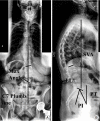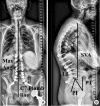Outcomes of Surgical Treatment for Patients With Mild Scoliosis and Age-Appropriate Sagittal Alignment With Minimum 2-Year Follow-up
- PMID: 37798979
- PMCID: PMC10562222
- DOI: 10.14245/ns.2346454.227
Outcomes of Surgical Treatment for Patients With Mild Scoliosis and Age-Appropriate Sagittal Alignment With Minimum 2-Year Follow-up
Abstract
Objective: The goal of this study was to determine if patients with mild scoliosis and age-appropriate sagittal alignment have favorable outcomes following surgical correction.
Methods: Retrospective review of a prospective, multicenter adult spinal deformity database. Inclusion criteria: operative patients age ≥18 years, and preoperative pelvic tilt, mismatch between pelvic incidence and lumbar lordosis (PI-LL), and C7 sagittal vertical axis all within established age-adjusted thresholds with minimum 2-year follow-up. Health-related quality of life (HRQoL) scores: Oswestry Disability Index (ODI), 36-item Short Form health survey (SF-36), Scoliosis Research Society-22R (SRS22R), back/leg pain Numerical Rating Scale and minimum clinically important difference (MCID)/substantial clinical benefit (SCB). Two-year and preoperative HRQoL radiographic data were compared. Patients with mild scoliosis (Mild Scoli, Max coronal Cobb 10°-30°) were compared to those with larger curves (Scoli).
Results: One hundred fifty-one patients included from 667 operative patients (82.8% women; average age, 56.4 ± 16.2 years). Forty-two patients (27.8%) included in Mild Scoli group. Mild Scoli group had significantly worse baseline leg pain, ODI, and physical composite scores (p < 0.02). Mean 2-year maximum coronal Cobb angle was significantly improved compared to baseline (p < 0.001). All 2-year HRQoL measures were significantly improved compared to (p < 0.001) except mental composite score, SRS activity and SRS mental for the Mild Scoli group (p > 0.05). From the mild Scoli group, 36%-74% met either MCID or SCB for the HRQoL measures. Sixty-four point three percent had minimum 1 complication, 28.6% had a major complication, 35.7% had reoperation.
Conclusion: Mild scoliosis patients with age-appropriate sagittal alignment benefit from surgical correction, decompression, and stabilization at 2 years postoperative despite having a high complication rate.
Keywords: Adult spinal deformity; Complications; Mild scoliosis; Outcomes; Sagittal alignment.
Conflict of interest statement
The authors have nothing to disclose.
Figures



Comment in
-
Impacts of Adult Spinal Deformity Surgery on Coronal Malalignment: Commentary on "Outcomes of Surgical Treatment for Patients With Mild Scoliosis and Age-Appropriate Sagittal Alignment With Minimum 2-Year Follow-up".Neurospine. 2023 Sep;20(3):849-851. doi: 10.14245/ns.2346926.463. Epub 2023 Sep 30. Neurospine. 2023. PMID: 37798980 Free PMC article. No abstract available.
Similar articles
-
The likelihood of reaching minimum clinically important difference and substantial clinical benefit at 2 years following a 3-column osteotomy: analysis of 140 patients.J Neurosurg Spine. 2015 Sep;23(3):340-8. doi: 10.3171/2014.12.SPINE141031. Epub 2015 Jun 19. J Neurosurg Spine. 2015. PMID: 26091440
-
Association between preoperative cervical sagittal deformity and inferior outcomes at 2-year follow-up in patients with adult thoracolumbar deformity: analysis of 182 patients.J Neurosurg Spine. 2016 Jan;24(1):108-15. doi: 10.3171/2015.3.SPINE141098. Epub 2015 Sep 11. J Neurosurg Spine. 2016. PMID: 26360147
-
Multicenter assessment of surgical outcomes in adult spinal deformity patients with severe global coronal malalignment: determination of target coronal realignment threshold.J Neurosurg Spine. 2020 Dec 4;34(3):399-412. doi: 10.3171/2020.7.SPINE20606. Print 2021 Mar 1. J Neurosurg Spine. 2020. PMID: 33276327
-
Comparative analysis of 3 surgical strategies for adult spinal deformity with mild to moderate sagittal imbalance.J Neurosurg Spine. 2018 Jan;28(1):40-49. doi: 10.3171/2017.5.SPINE161370. Epub 2017 Nov 3. J Neurosurg Spine. 2018. PMID: 29087808
-
Two- and three-year outcomes of minimally invasive and hybrid correction of adult spinal deformity.J Neurosurg Spine. 2021 Nov 5;36(4):595-608. doi: 10.3171/2021.7.SPINE21138. Print 2022 Apr 1. J Neurosurg Spine. 2021. PMID: 34740175 Review.
Cited by
-
From the Editor-in-Chief: Featured Articles in the September 2023 Issue.Neurospine. 2023 Sep;20(3):731-732. doi: 10.14245/ns.2346874.437. Epub 2023 Sep 30. Neurospine. 2023. PMID: 37798966 Free PMC article. No abstract available.
-
Impacts of Adult Spinal Deformity Surgery on Coronal Malalignment: Commentary on "Outcomes of Surgical Treatment for Patients With Mild Scoliosis and Age-Appropriate Sagittal Alignment With Minimum 2-Year Follow-up".Neurospine. 2023 Sep;20(3):849-851. doi: 10.14245/ns.2346926.463. Epub 2023 Sep 30. Neurospine. 2023. PMID: 37798980 Free PMC article. No abstract available.
References
-
- Bess S, Boachie-Adjei O, Burton D, et al. Pain and disability determine treatment modality for older patients with adult scoliosis, while deformity guides treatment for younger patients. Spine (Phila Pa 1976) 2009;34:2186–90. - PubMed
-
- Glassman SD, Schwab FJ, Bridwell KH, et al. The selection of operative versus nonoperative treatment in patients with adult scoliosis. Spine (Phila Pa 1976) 2007;32:93–7. - PubMed
-
- Smith JS, Fu KM, Urban P, et al. Neurological symptoms and deficits in adults with scoliosis who present to a surgical clinic: incidence and association with the choice of operative versus nonoperative management. Journal of neurosurgery. J Neurosurg Spine. 2008;9:326–31. - PubMed
-
- Bridwell KH, Baldus C, Berven S, et al. Changes in radiographic and clinical outcomes with primary treatment adult spinal deformity surgeries from two years to three- to fiveyears follow-up. Spine (Phila Pa 1976) 2010;35:1849–54. - PubMed
LinkOut - more resources
Full Text Sources
Research Materials
Miscellaneous

